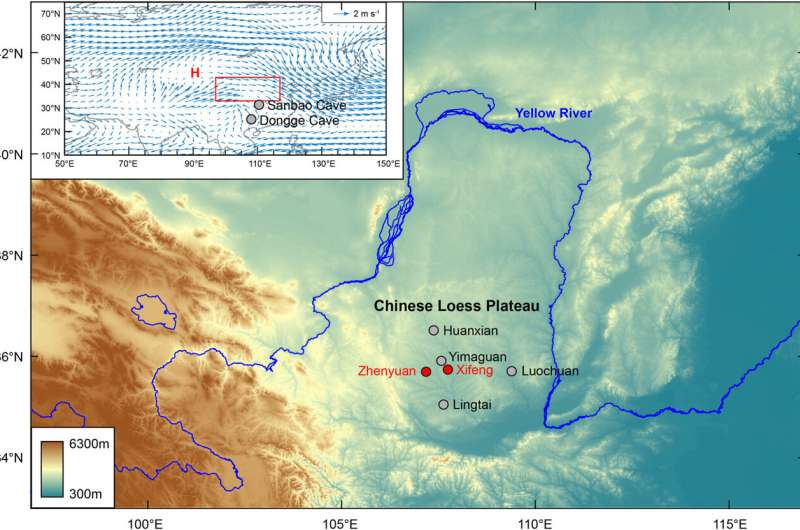This article has been reviewed according to Science X's editorial process and policies. Editors have highlighted the following attributes while ensuring the content's credibility:
fact-checked
peer-reviewed publication
trusted source
proofread
Study reveals evolution and potential forcing mechanisms of East Asian winter monsoon during glacial inceptions

The East Asian winter monsoon (EAWM) is a major component of the East Asian monsoon circulation, and its intensity is closely linked to the volume of the Northern Hemisphere ice sheets (NHIS) on orbital timescale.
The "sawtooth" pattern of global ice volume shows a gradual build-up of the ice sheets (in ~90,000 years) followed by rapid deglaciation (in ~10,000 years) since the middle Pleistocene transition. However, the loess records of EAWM showed distinct glacial and interglacial modes, with the transitions between them generally being quick.
Recently, researchers led by Associate Professor Li Tao from the Nanjing Institute of Geology and Paleontology of the Chinese Academy of Sciences (NIGPAS) and their collaborators conducted a high-resolution secondary carbonate (microcodium) Sr isotope (87Sr/86Sr) study from two loess-paleosol sequences on the central Chinese Loess Plateau (CLP), and developed an independent chronology framework for assessing the evolution and potential forcing mechanisms of the EAWM during glacial inceptions over the last 550,000 years.
The study was published in Geophysical Research Letters on Feb. 7.
Based on this independent chronology and integrating multi-proxy records, the researchers provide new insights into the dynamics of EAWM during glacial inceptions.
"Our study shows new secondary carbonate (microcodium) 87Sr/86Sr record and integrates multi-proxy records from the central CLP to reinterpret the response of the EAWM to insolation and ice-sheet forcing during glacial inceptions," said Prof. Li.
Microcodium 87Sr/86Sr record, which captures the global cooling trend at the transition zones between the paleosol layer and the overlying loess layer, provides an independent age control for comparing loess records with other paleoclimatic records during glacial inceptions.
The researchers found that concurrent abrupt shifts occurred in the EAWM and East Asian summer monsoon (EASM) during glacial inceptions. The gradual declining summer insolation in Northern Hemisphere high-latitudes during glacial inceptions might trigger an abrupt weakening of Atlantic meridional overturning circulation (AMOC) and thus cooling in the northern North Atlantic, which strengthened the Siberian-Mongolian High cell and the EAWM but weakened the EASM.
Nevertheless, the insolation-triggered abrupt weakening of AMOC alone cannot account for the mode shift in the EAWM during glacial inceptions. For example, the δ18O record from the Iberian Margin and the modeling results both indicated a sharp weakening of AMOC at the Marine Isotope Stage (MIS) 5e/5d transition while the loess records showed no significant changes in the EAWM from MIS 5e to MIS 5a. This indicates that the gradual build-up of the NHIS may have played an important role in preconditioning the rapid, coupled shifts in the EAWM and EASM during the glacial inceptions.
The key role of NHIS in modulating the insolation-triggered abrupt changes in the EAWM at the end of interglacial was further supported by the absence of an abrupt shift in the EAWM at the MIS 11/10 transition when the build-up of NHIS was delayed due to the eccentricity minima.
"Our results thus provide compelling evidence for the nonlinear response of the EAWM to ice volume and insolation forcing during the interglacial-glacial transitions," said Prof. Li.
More information: Tao Li et al, Ice Volume and Insolation Forcing of Abrupt Strengthening of East Asian Winter Monsoon During Glacial Inceptions, Geophysical Research Letters (2023). DOI: 10.1029/2022GL102404
Journal information: Geophysical Research Letters
Provided by Chinese Academy of Sciences




















